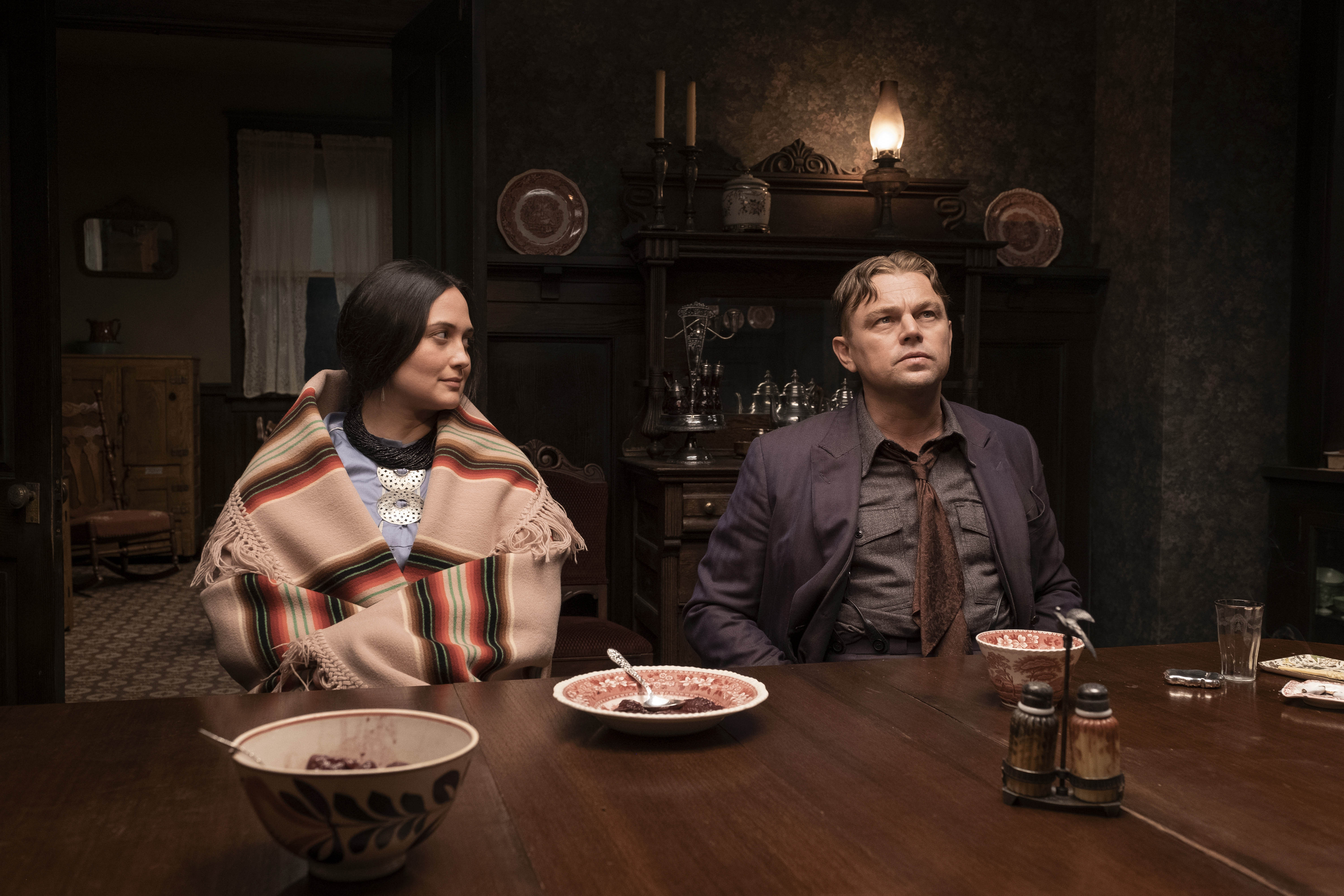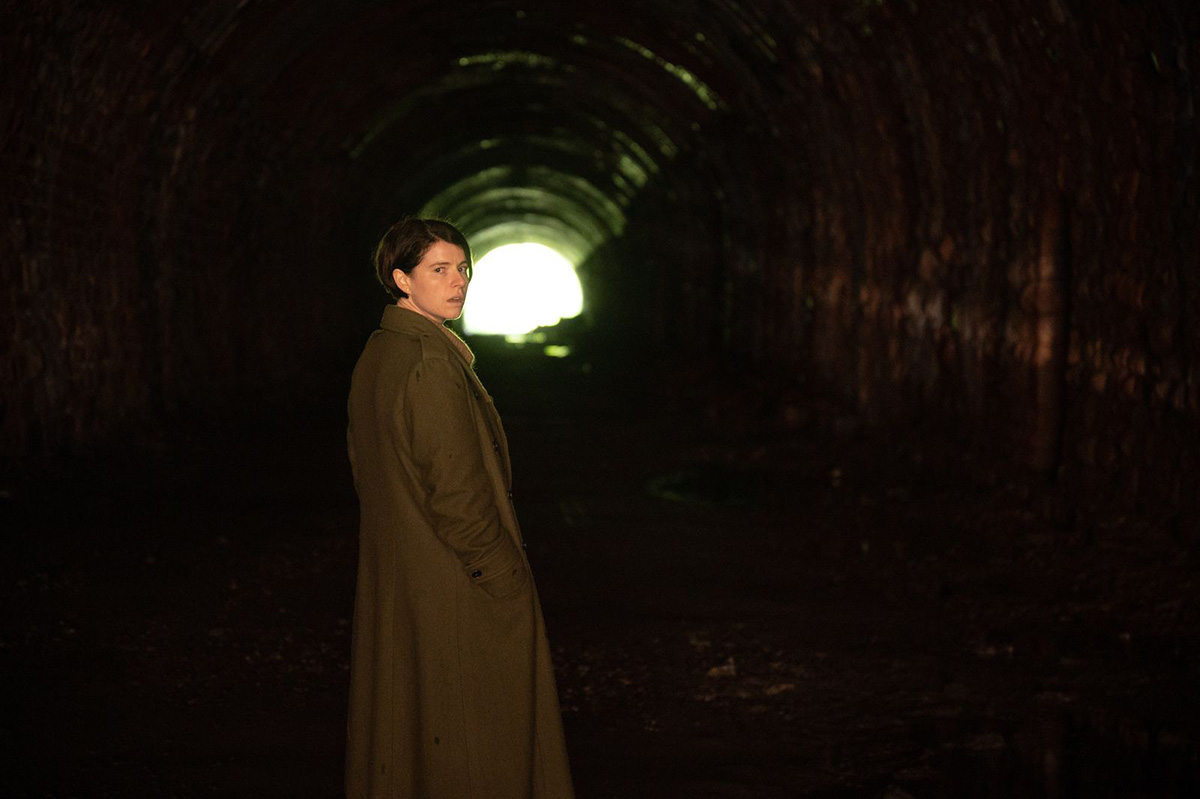Film review: With slow burn, ‘Killers of the Flower Moon’ meticulously confronts American greed

Lily Gladstone (left) and Leonardo DiCaprio (right) play Mollie and Ernest Burkhart in “Killers of the Flower Moon.” Co-written by Martin Scorsese, the director’s 26th feature film released in theaters Friday. (Courtesy of Apple TV+)
“Killers of the Flower Moon”
Directed by Martin Scorsese
Apple TV+ and Paramount Pictures
Oct. 20

By Natalie Agnew
Oct. 20, 2023 9:17 p.m.
This post was updated Oct. 22 at 7:46 p.m.
“Can you find the wolves in this picture?” The perpetrators are devastatingly captured on the silver screen.
Released in theaters Friday, Martin Scorsese’s 26th feature film “Killers of the Flower Moon” transports audiences to 1920s Oklahoma, clinically documenting a series of murders of members of the Osage Nation. No stranger to period pieces or crime sagas, Scorsese returns to familiar territory with frequent collaborators Robert De Niro and Leonardo DiCaprio helming the cast. The staggeringly scaled epic deftly reckons with horror-tinged greed and violence that permeate American history while succumbing to its own ambition with a drawn-out runtime and amorphous plot.
The picture is based on journalist David Grann’s “Killers of the Flower Moon: The Osage Murders and the Birth of the FBI,” a nonfiction book outlining the killing of members of the oil-rich tribe in pursuit of their wealth, as well as how the newly established FBI ultimately uncovered the conspiracy. Deviating from the source material, the screenplay written by Scorsese and Eric Roth centers the tangled relationship between World War I veteran Ernest Burkhart (DiCaprio) and his wife, Osage woman Mollie Burkhart (Lily Gladstone), rather than the FBI investigation. In fact, investigator Tom White (Jesse Plemons) does not make an appearance until the final act.
[Related: Film preview: Fall’s forthcoming films include historical adaptations, franchise favorites]
Wide shots of the Oklahoma prairie and the craftily constructed town of Fairfax paint an engrossing backdrop immediately from the opening scenes. The audience is introduced to the film’s setting through Ernest’s eyes upon his arrival, where he reunites with his uncle William, or “King” Hale (De Niro). However, despite what the setup may suggest, this isn’t a conventional whodunnit – it’s clear from the outset that King is the orchestrator of these murders, with Ernest as a bumbling participant.
Thirty years since they first worked opposite each other in “This Boy’s Life,” De Niro carries an air of chilling authority masked by compassion that juxtaposes DiCaprio’s portrayal of an obtuse yet somewhat charming Ernest. While not dissimilar from his likeably pathetic depiction of Rick Dalton in “Once Upon a Time in Hollywood,” DiCaprio adds a layer of malice with his permanent frown and pinched brows shading every even-tempered smile.
In its grand scope, the film falls short by focusing too closely on its male leads, and, in turn, the white killers. Though lacking screen time compared to the two A-listers, Gladstone’s quietly gut-wrenching performance as Mollie provides a much-needed emotional anchor. In a particularly striking scene nearing the conclusion, Mollie and Ernest speak after his rattling testimony, and he reveals the depth of his betrayal. Eyes brimming with immense sorrow, Gladstone commands every bit of attention as she implores, “Have you told all of your truths?” staring directly into the soul of a man who will still not meet her eyes.
The tense character study is seamlessly accompanied by Robbie Robertson’s ominous score, the methodical thudding of the bass string foretelling violence at every turn. The score harmonizes with cinematographer Rodrigo Prieto’s subdued gray-scaled color palette – a stark contrast from his work in “Barbie” this year – and lingering shots that create a steady burning sense of dread.
On par with his more recent projects such as “Silence” and “The Irishman,” Scorsese trudges through the series of events with discipline, even if it results in the lengthy runtime being unmistakable. However, to his credit, each of the 206 minutes is painfully felt by audiences. The cynical nature of the plot, though repetitive, mirrors the enormity and continuity of the violence inflicted upon the Osage Nation.
Departing from Scorsese’s typical style, this film doesn’t feature flashy montages set to Rolling Stones needle drops or dynamic shifting camerawork – a reminder the project is not “Goodfellas” or “The Wolf of Wall Street.” Scorsese holds the audience at a detached distance, in which the camera is a documentarian rather than an active participant with no trademark voiceover to step inside Ernest’s mind. Theatergoers are rendered bystanders, unflinchingly observing the grotesque force of capitalist, colonialist greed.
Although Scorsese does not create a spectacle that falls victim to glorification, of which he has previously been accused, the film still spotlights the moral dilemma of the white antagonists much like his other projects. Moments that could have been spent exploring the gruesome depth of corruption with extended historical context or the FBI investigation are instead dedicated to Ernest facing down his uncle and judgment for his sins.
[Related: Film review: ‘Oppenheimer’ employs unprecedented technical brilliance to redefine biopic genre]
As upbeat Western credit music plays, the ending remarkably captures the magnitude of injustice and directly confronts the film’s shortcomings through the lens of a live radio show. On the stage, white men present an overdramatic epilogue of the events to an all-white audience, complete with caricature voices and sound effects. Its implication is that Scorsese has created entertainment profiting off the pain of the Osage Nation, narrated through the eyes of flawed white protagonists to cater to a white audience. Staring into the mirror of his legacy, the director takes center stage in a characteristic cameo to read Mollie’s eulogy and reveals the murders were not mentioned in it.
The road to the American dream was paved by horror – this should neither be forgotten nor romanticized.




